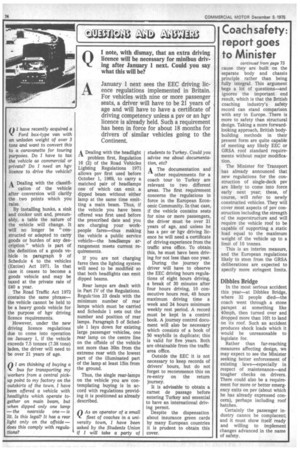Coach safety: report goes to the Minister
Page 77

Page 78

If you've noticed an error in this article please click here to report it so we can fix it.
by CM reporter THE MINISTER FOR TRANSPORT, Dr John Gilbert, has now received his officials' report on coach safety, which he commissioned as a result of a tragic spate of accidents involving coaches. The phrase " involving coaches" is deliberate: one of the first things which the Minister will probably have noted is that in at least six out of some 20 such accidents between May and September, the cause of the accident almost certainly lay with the other party involved.
He will also note the tremendous variety of conditions surrounding the accidents this year. Until the report is made public, or the Minister announces his intentions, we cannot know for certain whether some fault or failing occurred sufficiently often to constitute a key' problem, but it seems unlikely. Figures for 21 accidents this summer involving coaches, produced by the Confederation of British Road Passenger Transport, reveal no pattern.
Suggestions that t here should be changes in the law on part-time drivers, roll-over strength or vehicle maintenance all spring from isolated incidents. There may certainly be a case for tightening up existing laws, but panic legislation could produce far-reaching and unintended results.
If a real new problem does exist in coach safety—and there is little evidence to suggest this—then it must obviously be clearly identified, and the solution applied with care. For instance, it would be essential to decide whether any changes in legislation should apply to both buses and coaches. Many busmen are increasingly worried that the Government might seek some universal strength requirement for pay, thus including buses which are limited by their type of operation as to maximum speed and length of journey.
The Confederation itself stresses that the incidence of coaches turning over is very small. It stresses that body strength is far more important than roof strength. Even when the area of passenger transport which might be affected by new legislation has been identified, it will be no easy task to decide on action that would have an immediate and beneficial effect. The Confederation analysis of 21 accidents this year involving coaches shows how varied were the factors and conditions.
Variety of conditions
For instance, they were spread evenly over days of the week, and the road conditions varied enormously; five took place on steep hills, two on dual carriageways, one on a suburban road, four on motorways, two at cross-roads, one on an underpass and six on other types of road. Only three of the 21 coaches were driven by part-time drivers, and in every case the operator claimed that the drivers were within their legal hours.
In five cases the coach overturned, in six cases it was hit by another vehicle, in two cases a vehicle ran into the path of the coach and was struck by the coach. The makes of coach covered almost the whole spread of current British chassis; 15 of the coaches were operated by "independents," five by the NBC and one by Ulsterbus.
This year's fatal accidents have understandably put coach safety in the headlines, but for those people involved in the passenger industry the subject has been one of continuing concern over the years. Particularly in bodies like GRSA which has been working on a common standard for safety features—including roof strength—for some years now.
Implementation of the code of practice laid down by GRSA (revealed exclusively in our Passenger Transport Number last year) is not far away, and it would surely be more sensible to await this closely detailed engineering document. than to rush in with makeshift rules.
It has been said that British coaches are inherently less safe than Continental ones be continued from page 73 cause they are built on the separate body and chassis principle rather than being fully integral. This argument begs a lot of questions—and ignores the important end result, which is that the British coaching industry's safety record can stand comparison with any in Europe. There is more to safety than structural design. Taking a more forwardlooking approach, British bodybuilding methods in their present form are quite capable of meeting any likely EEC or GRSA roof standard requirements without major modification.
The Minister for Transport has already announced that new regulations for the construction of single-deck psv are likely to come into force early next year; these, of course, will refer to newly constructed vehicles. They will cover most aspects of psv construction including the strength of the superstructure and will require the vehicle roof to be capable of supporting a static load equal to the maximum eight of the vehicle up to a limit of 10 tonnes.
This is an interim measure, and the European regulations likely to stem from the GRSA deliberations are expected to specify more stringent limits.
Dibbles Bridge
In the most serious accident this year—at Dibbles Bridge, where 32 people died—the coach went through a stone parapet at something like 40mph, then turned over and dropped more than 10ft to land on its roof. Such an accident produces shock loads which it would be unreasonable to legislate for.
Rather than far-reaching measures affecting design, we may expect to see the Minister seeking better enforcement of existing laws—especially in respect of maintenance—and tougher checks on drivers. There could also be a requirement for more or better emergency exits on psv (about which he has already expressed concern), perhaps including roof hatches.
Certainly the passenger industry cannot be complacent; and it must show itself ready and willing to implement changes advanced in the name of safety.


































































































































